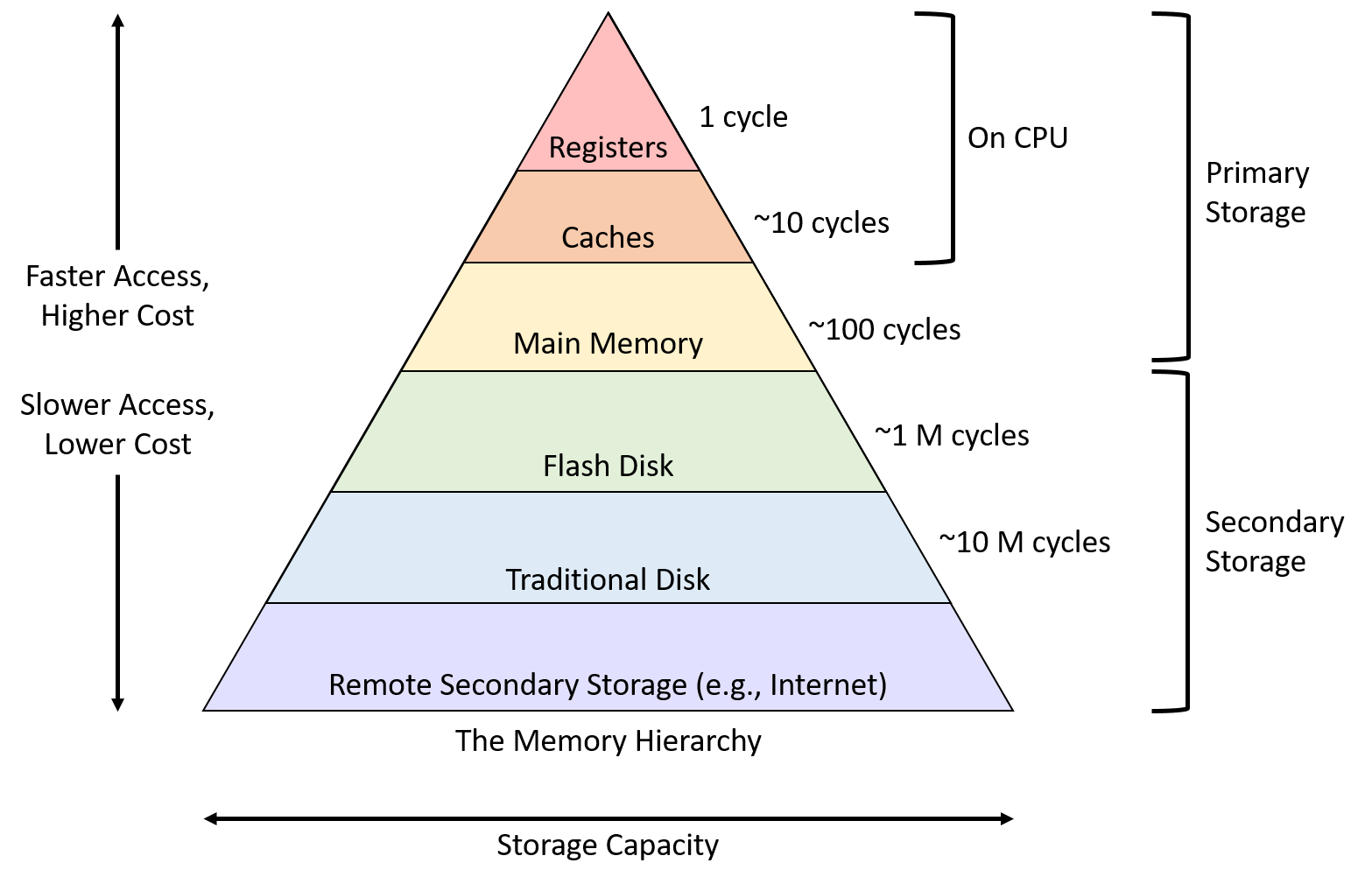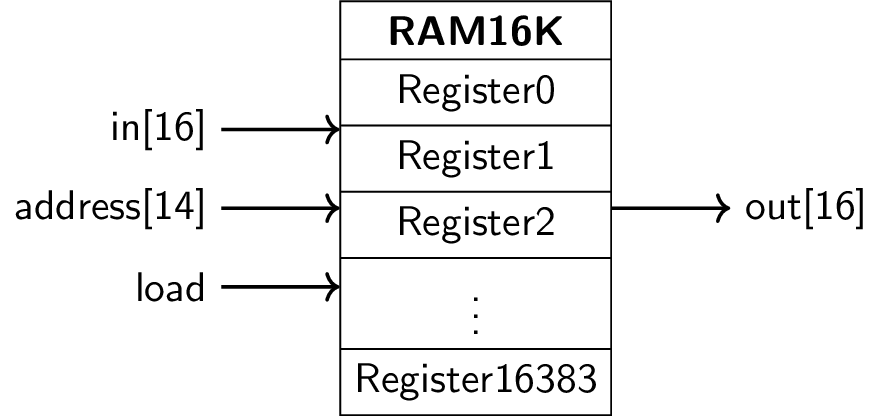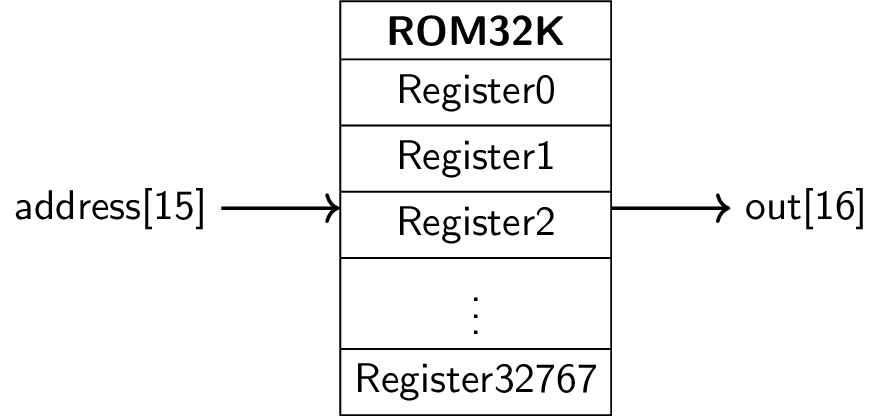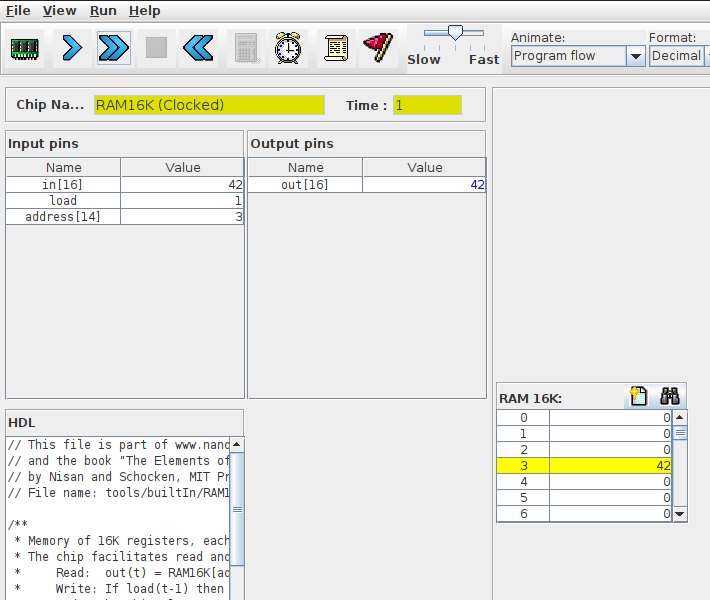Hack Memory
(Usage hints for this presentation)
IT Systems, Summer Term 2025
Dr. Jens Lechtenbörger (License Information)
1. Introduction
1.1. Today’s Core Question
- What are bits, bytes, words, registers, RAM, ROM?
- Based on Chapter 3 of (Nisan and Schocken 2005)
- (We skip Project 3)
1.2. Retrieval Practice
Recall the Hack computer architecture preview
- What types of memory exist in Hack for what purposes?
- How do memory, ALU, and PC interact?
1.3. Learning Objectives
- Explain memory hierarchy
- Explain functionality of RAM, ROM, PC
- In particular for Hack chips
- Convert memory sizes (bits, bytes, larger sizes)
Agenda
2. Memory
2.1. Sequential Circuits
- Previously, combinational circuits
- Output depends on input combinations
- Pure functions, e.g., Nand, ALU
- Now, sequential circuits: Output depends on input combination, clock
signal, and state
- Calculations based on sequence of (previous) inputs
- Sequence triggered/synchronized by clock: one step or cycle per clock tick
- Calculations based on sequence of (previous) inputs
- Memory chips, RAM, ROM
- Computer with RAM and CPU
2.2. Bit, Byte, Word
- Bit (b): Smallest unit, zero or one
- Word: CPU specific width for unit of processing
- Hack: 16 bits, more typical: 32 or 64 bits
- Byte (B): 8 bits, typical unit of addressing in modern CPUs
- But not in Hack architecture
- In Hack, addresses refer to 16-bit words, not to 8-bit bytes
- Byte can be understood as unsigned 8-bit integer
- Between 0 and 255
- But not in Hack architecture
2.2.1. Units for Memory
- Base 10 and base 2 for larger (or smaller) quantities
- Systeme international d’unites (SI)
- Prefixes based on powers of 10
- “Normal”: kilo/k (\(10^3\)), mega/M (\(10^6\)), micro/μ (\(10^{-6}\)),
nano/n (\(10^{-9}\)), …
- 16 kB = 16,000 B (16 kilobytes)
- IEC (International Electrotechnical Commission)
- Prefixes based on powers of 2
- “New”: kibi/Ki (\(1024\)), mebi/Mi (\(1024^2\)), gibi/Gi (\(1024^3\)), …
- \(16\) KiB = \(16 \cdot 1024\) B = \(16384\) B (16 kibibytes)
- Systeme international d’unites (SI)
- Typical convention
- For RAM (main memory), use powers of 2
- For disks (secondary memory), use powers of 10
2.3. Memory Hierarchy
Registers: Small memory, in CPU
![The memory hierarchy]()
“The memory hierarchy” Copyright (C) 2020 Dive into Systems, LLC under CC BY-NC-ND 4.0; from Dive into Systems
- Each register stores a word
- Small, expensive, fast (< 1 ns access)
- RAM (main/primary memory): larger memory, on mainboard
- Think of array of registers
- Address input determines what register to access
- Byte-addressed in real RAM, word-addressed in Hack
- Read/write accesses possible in random order, at equal speed
- Still fast (100 ns access time)
- CPU caches: Hierarchy of memory devices
- Copy of recently used data between RAM and CPU
- Level 1, L1: closest, smallest, fastest (1 ns access)
- Level 2, L2: farther away, larger, slower (4 ns access)
- Secondary memory: Flash/solid-state disks (16 μs), traditional/hard disks
(several ms)
- Much larger and slower, persistent, cheap
3. Hack Memory
3.1. Memory Chips
- Sequence of chips of increasing sizes
- Built-in
DFFandBit- Single bit
- 16-bit
Registerfor one word RAM8,RAM64,RAM512,RAM4K,RAM16K- RAM chips of increasing sizes (8 words, 64 words, …)
- With inputs
in,address,load; outputout - If
loadis 1, storeinataddress; otherwise, keep state - Output current contents at
addressasout
- With inputs
RAM16K: \(2^{14} = 16384\) words
- RAM chips of increasing sizes (8 words, 64 words, …)
- Built-in
3.2. Hack ROM
Nand2Tetris with built-in chip
ROM32K- Input
address[15] - Output
out[16] - (\(2^{15} = 32768\) words)
- Input
- Output current contents at
addressasout- Only reading, contents written upon fabrication
- (Later: ROM initialized with instructions when program is loaded)
3.3. Hack PC
Recall: Program Counter (PC) holds address of next machine instruction to execute
- Inputs
in[16],- Control bits:
reset,load,inc
- Output
out[16]
- Inputs
- Output current register contents as
outLogic
if reset then store 0 elif load then store in elif inc then increment stored value else keep state
4. Conclusions
4.1. Summary
- Memory organized in hierarchy of levels
- Considerable differences regarding size, speed, cost
- From registers over caches to RAM and secondary storage
- Registers located inside CPU, including the program counter
- RAM can be understood as array of registers
- RAM is byte-addressed in real hardware, word-addressed in Hack
- Outlook
- CPU includes registers
- Computer includes registers, RAM, ROM
4.2. Self-Study
Play with
RAM16KandPCin Hardware Simulator- (Use built-in chips)
- Note
- Area for RAM contents
- For
RAM16K,addressenumerates 16-bit words, neither bits nor bytes
- How large is RAM16K in bits, bytes, words, KiB?
Bibliography
License Information
Source files are available on GitLab (check out embedded submodules) under free licenses. Icons of custom controls are by @fontawesome, released under CC BY 4.0.
Except where otherwise noted, the work “Hack Memory”, © 2024-2025 Jens Lechtenbörger, is published under the Creative Commons license CC BY-SA 4.0.





